2014 MITSUBISHI LANCER SPORTBACK tow
[x] Cancel search: towPage 12 of 422

2-1
2
If this warning light comes on or
flashes while you’re driving...
Quick index
N00200701077
If this warning light comes on or flashes while you’re driving...
NOTE
For information regarding warning displays in the multi-informat
ion display, refer to “Multi-information display” on page 5-108
.
These warning lights will come on for a few seconds for a bul
b check when the ignition switc
h is first turned to “ON”.
Warning light
Do this
Ref. page
Charging system warning light
Park your vehicle in a safe
place and stop the engine.
Contact an authorized Mitsubishi Motors
dealer or a repair facility of your
choice for assistance.
P.5-143
or
Brake warning light
If this light comes on while driving, check to see that the parking brake is fully released. If this light stays on after releasing the parking brake, stop and check the brake fluid level. If the brake fluid level is correct, th
ere may be a system malfunction. Avoid
hard braking and high speeds, and contact an authorized Mitsubishi Motors dealer or a repair facility of your choice for assistance.
P.5-142
or
Engine malfunction indicator
(“SERVICE ENGINE SOON” or “Check engine
light”)
Although your vehicle will usually be drivable and not need towing, have the engine system checked at an aut
horized Mitsubishi Motors dealer or a
repair facility of your choice as soon
as possible. If the vehicle is not driv-
able, contact emergency roadside assistance at 1-888-648-7820 (for vehi- cles sold in U.S.A.) or 1-888-576-487
8 (for vehicles sold in Canada), an
authorized Mitsubishi Motors dealer
, or local towing company for assis-
tance.
P.5-142
BK0200700US.bo
ok 1 ページ 2013年2月15日 金曜日 午後12時17分
Page 16 of 422
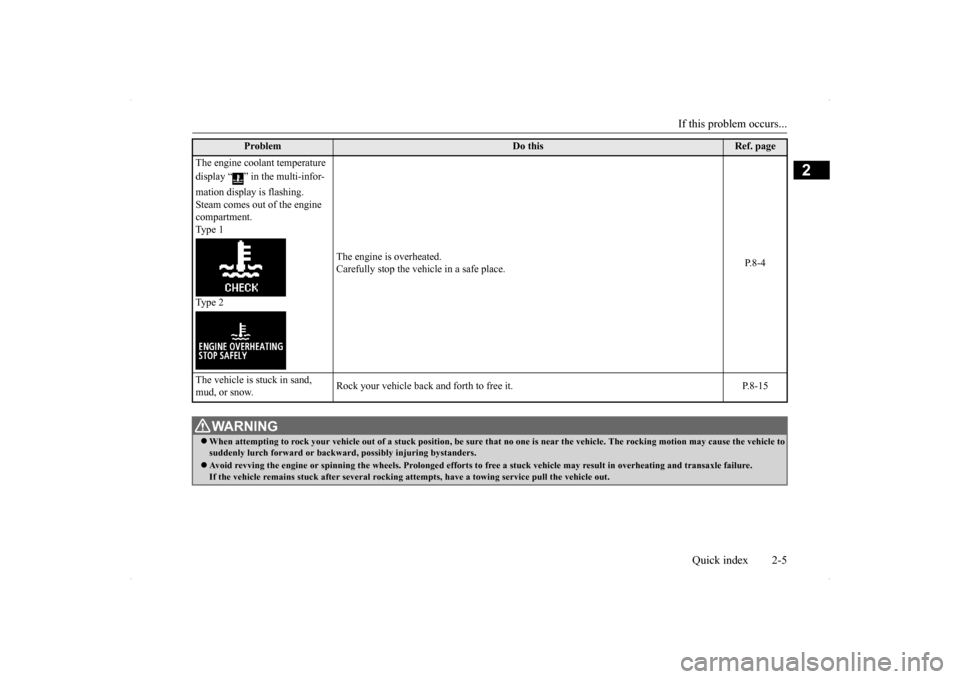
If this problem occurs...
Quick index 2-5
2
Problem
Do this
Ref. page
The engine coolant temperature display “ ” in the multi-infor- mation display is flashing. Steam comes out of the engine compartment. Type 1 Type 2
The engine is overheated. Carefully stop the vehicle in a safe place.
P.8-4
The vehicle is stuck in sand, mud, or snow.
Rock your vehicle back and forth to free it. P.8-15
WA R N I N G When attempting to rock your vehicle out of
a stuck position, be sure that no one is
near the vehicle. The rocking motion may c
ause the vehicle to
suddenly lurch forward or backward, possibly injuring bystanders. Avoid revving the engine or spinning the
wheels. Prolonged efforts to free a stuck ve
hicle may result in overheating and transa
xle failure.
If the vehicle remains stuck after several rocking at
tempts, have a towing service pull the vehicle out.
BK0200700US.bo
ok 5 ページ 2013年2月15日 金曜日 午後12時17分
Page 36 of 422
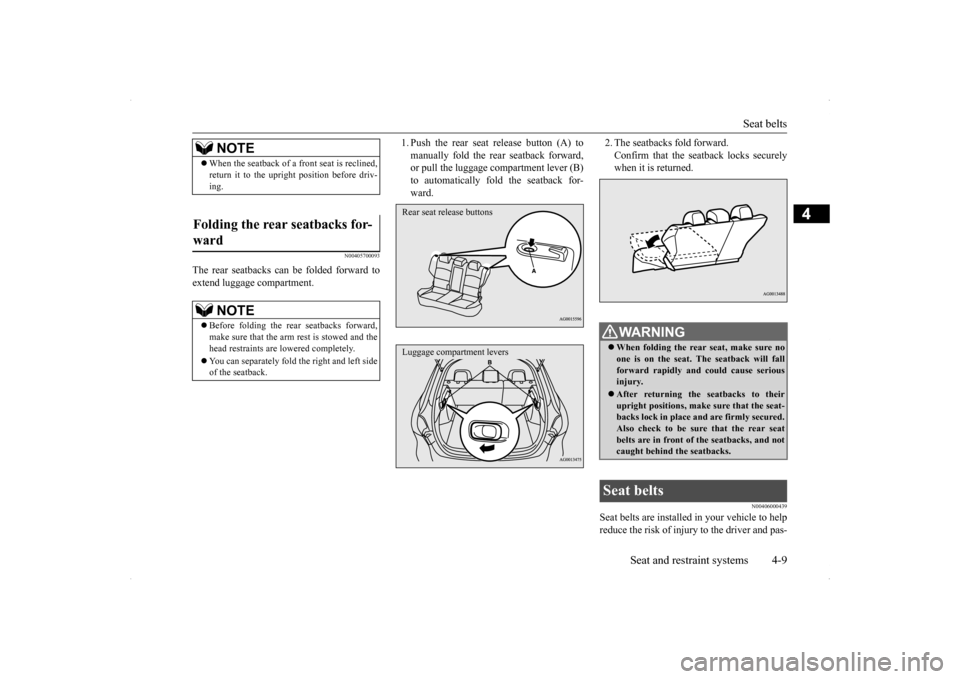
Seat belts
Seat and restraint systems 4-9
4
N00405700093
The rear seatbacks can be folded forward to extend luggage compartment.
1. Push the rear seat release button (A) to manually fold the rear seatback forward, or pull the luggage compartment lever (B) to automatically fold the seatback for-ward.
2. The seatbacks fold forward. Confirm that the seatback locks securely when it is returned.
N00406000439
Seat belts are installed in your vehicle to help reduce the risk of injury to the driver and pas-
NOTE
When the seatback of a front seat is reclined, return it to the upright position before driv- ing.
Folding the rear seatbacks for- ward
NOTE
Before folding the rear seatbacks forward, make sure that the arm rest is stowed and the head restraints are lowered completely. You can separately fold the right and left side of the seatback.
Rear seat release buttons Luggage compartment levers
WA R N I N G When folding the rear seat, make sure no one is on the seat. The seatback will fall forward rapidly and could cause serious injury. After returning the seatbacks to their upright positions, make sure that the seat-backs lock in place and are firmly secured. Also check to be sure that the rear seat belts are in front of the seatbacks, and notcaught behind the seatbacks.
Seat belts
BK0200700US.bo
ok 9 ページ 2013年2月15日 金曜日 午後12時17分
Page 41 of 422
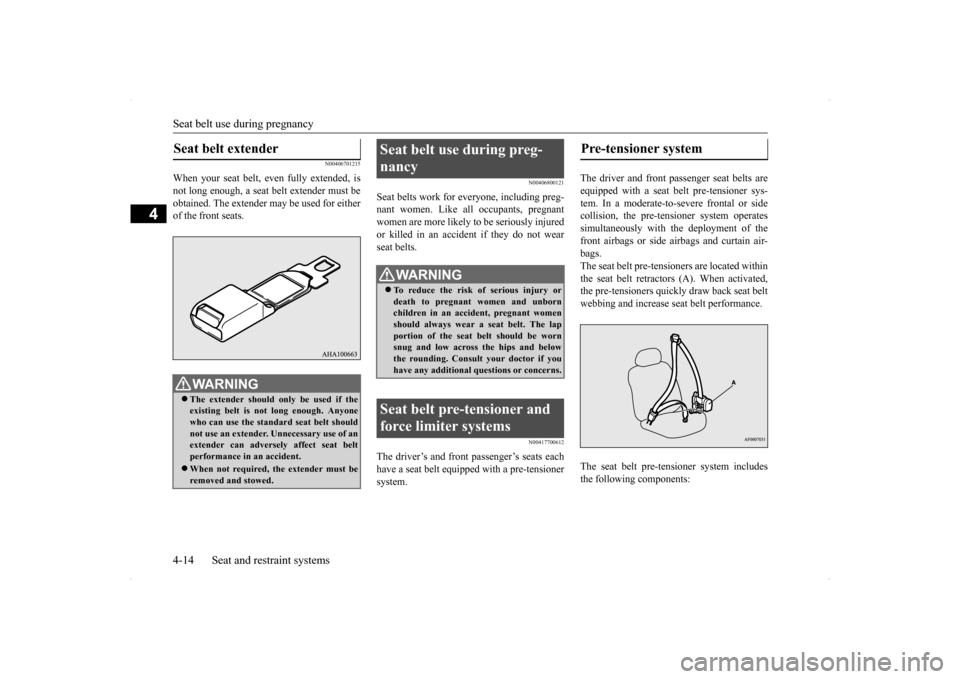
Seat belt use during pregnancy 4-14 Seat and restraint systems
4
N00406701215
When your seat belt, even fully extended, is not long enough, a seat belt extender must beobtained. The extender may be used for either of the front seats.
N00406800121
Seat belts work for ev
eryone, including preg-
nant women. Like all occupants, pregnantwomen are more likely to be seriously injured or killed in an accident if they do not wear seat belts.
N00417700612
The driver’s and front passenger’s seats eachhave a seat belt equipped with a pre-tensioner system.
The driver and front passenger seat belts are equipped with a seat belt pre-tensioner sys-tem. In a moderate-to-severe frontal or side collision, the pre-tensioner system operates simultaneously with the deployment of thefront airbags or side airbags and curtain air- bags. The seat belt pre-tensioners are located withinthe seat belt retractors (A). When activated,the pre-tensioners quickly draw back seat belt webbing and increase seat belt performance. The seat belt pre-tensioner system includes the following components:
Seat belt extender
WA R N I N G The extender should only be used if the existing belt is not long enough. Anyonewho can use the standard seat belt should not use an extender. Unnecessary use of an extender can adversely affect seat beltperformance in an accident. When not required, the extender must be removed and stowed.
Seat belt use during preg- nancy
WA R N I N G To reduce the risk of serious injury or death to pregnant women and unbornchildren in an accident, pregnant women should always wear a seat belt. The lap portion of the seat belt should be wornsnug and low across the hips and below the rounding. Consult your doctor if you have any additional questions or concerns.
Seat belt pre-tensioner and force limiter systems
Pre-tensioner system
BK0200700US.bo
ok 14 ページ 2013年2月15日 金曜日 午後12時17分
Page 70 of 422
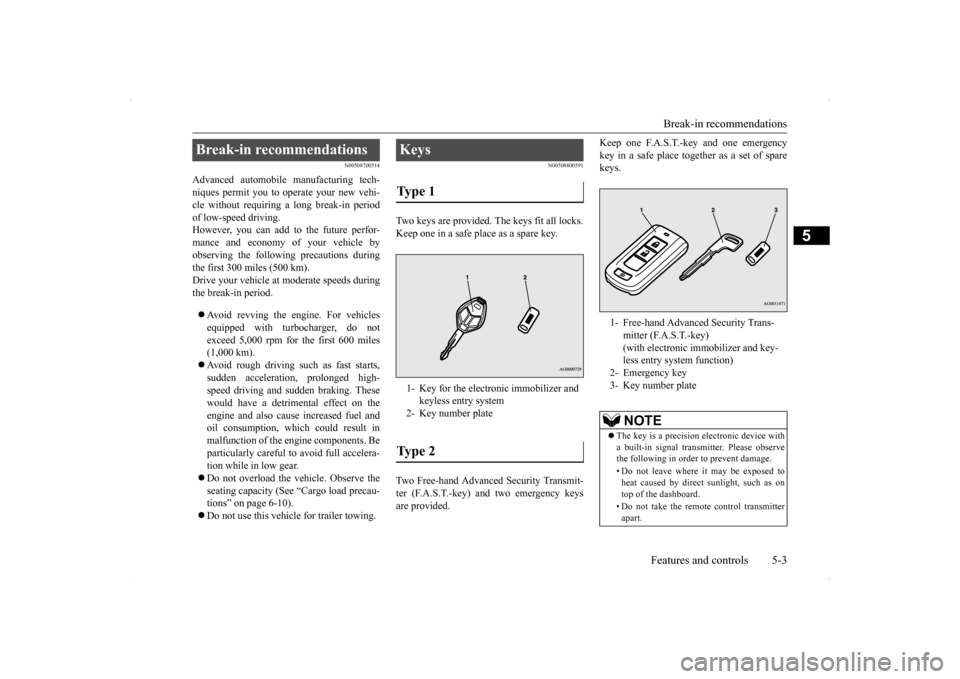
Break-in recommendations
Features and controls 5-3
5
N00508700314
Advanced automobile manufacturing tech- niques permit you to operate your new vehi-cle without requiring a long break-in period of low-speed driving. However, you can add to the future perfor-mance and economy of your vehicle by observing the following precautions during the first 300 miles (500 km).Drive your vehicle at moderate speeds duringthe break-in period. Avoid revving the engine. For vehicles equipped with turbocharger, do not exceed 5,000 rpm for the first 600 miles(1,000 km). Avoid rough driving such as fast starts, sudden acceleration, prolonged high-speed driving and sudden braking. These would have a detrimental effect on the engine and also cause increased fuel andoil consumption, which could result in malfunction of the engine components. Be particularly careful to avoid full accelera-tion while in low gear. Do not overload the vehicle. Observe the seating capacity (See “Cargo load precau-tions” on page 6-10). Do not use this vehicle for trailer towing.
N00508800591
Two keys are provided. The keys fit all locks. Keep one in a safe place as a spare key. Two Free-hand Advanced Security Transmit- ter (F.A.S.T.-key) and two emergency keys are provided.
Keep one F.A.S.T.-key and one emergency key in a safe place together as a set of spare keys.
Break-in recommendations
Keys Type 1 1- Key for the electronic immobilizer and
keyless entry system
2- Key number plateType 2
1- Free-hand Advanced Security Trans-
mitter (F.A.S.T.-key) (with electronic immobilizer and key-less entry system function)
2- Emergency key 3- Key number plate
NOTE
The key is a precision electronic device with a built-in signal transmitter. Please observe the following in order to prevent damage. • Do not leave where it may be exposed to heat caused by direct sunlight, such as ontop of the dashboard. • Do not take the remote control transmitter apart.
BK0200700US.bo
ok 3 ページ 2013年2月15日 金曜日 午後12時17分
Page 77 of 422

Keyless entry system (if so equipped) 5-10 Features and controls
5
ii. Release both the LOCK and UNLOCK buttons for 1 second.
iii. Press the UNLOCK button.
The answerback function informs youthat the ID code registration of the transmitter is completed.
5. To register the ID codes of additionalremote control transmitters, repeat step 4 within 60 seconds after step 4. 6. If no ID code of a remote control trans-mitter is registered within 60 secondsafter step 4, the registration mode is can- celed and the normal mode returns.
N0054610
1111
Your keyless entry system operates on a radio frequency subject to Federal Communica- tions Commission (FCC) Rules (For vehiclessold in U.S.A.) and Industry Canada Rules (For vehicles sold in Canada). This device
complies with Part 15 of FCC Rules and Industry Canada licence-exempt RSS stan- dard(s). Operation is subject to the following two con-ditions. This device may not cause harmful inter- ference. This device must accept any interference received, including interference that may cause undesired operation.
N00544100077
1. Before replacing the battery, remove static electricity from your body by touching ametal grounded object.
NOTE
For verification purposes, try to lock and unlock the doors and the rear hatch after theregistration is completed. The indicator light (4) comes on each time a button is pressed. The keyless entry system does not work if the key is in the ignition switch. The remote control transmitter can be used from about 40 feet (12 m) away. However, this distance may change if your vehicle is near a TV transmitting tower, a power sta- tion, or a radio station. If the UNLOCK button (2) is pressed when all doors and the rear hatch are locked and no doors or the rear hatch are opened withinabout 30 seconds, the doors and the rear hatch will automatically re-lock.
If the following conditions are observed after pressing the buttons on the remote control transmitter, the battery in the remote control transmitter may need to be replaced. • The doors and the rear hatch cannot be locked or unlocked. • The panic alarm cannot be operated. • The indicator light (4) is dim or does not come on.
If you lose your remote control transmitter, please contact an authorized Mitsubishi Motors dealer for a replacement. If you wish to obtain an additional remote control transmitter, please contact an autho- rized Mitsubishi Motors dealer. A maximumof eight remote control transmitters can be programmed for your vehicle. To use the new remote control transmitters, it is necessary to register the key with both the electronic immobilizer and keyless entry sys-tem. Also refer to “Electr
onic immobilizer (Anti-
theft starting system): Customer key pro-gramming” on page 5-6.
General information
NOTE
CAUTION Changes or modifications not expressly approved by the manufacturer for compli- ance could void the user’s authority to oper- ate the equipment.
Procedure for replacing the remote control transmitter bat- tery
BK0200700US.bo
ok 10 ページ 2013年2月15日 金曜日 午後12時17分
Page 79 of 422
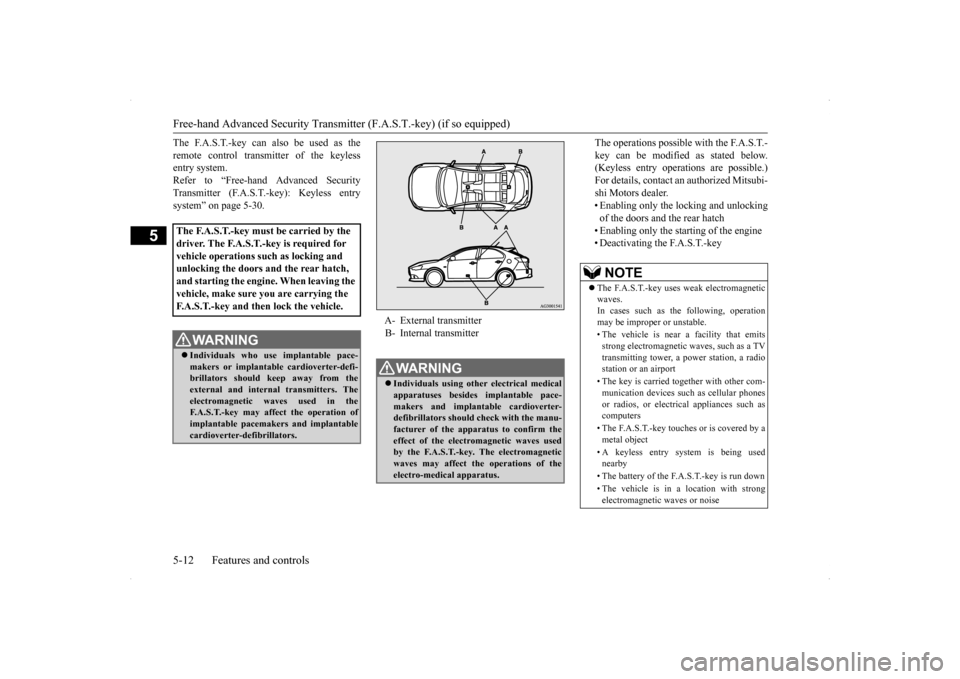
Free-hand Advanced Security Transmitter (F.A.S.T.-key) (if so equipped) 5-12 Features and controls
5
The F.A.S.T.-key can also be used as the remote control transmitter of the keyless entry system. Refer to “Free-hand Advanced SecurityTransmitter (F.A.S.T.-key): Keyless entry system” on page 5-30.
The operations possible with the F.A.S.T.- key can be modified as stated below. (Keyless entry operations are possible.) For details, contact an authorized Mitsubi-shi Motors dealer. • Enabling only the locking and unlocking of the doors and the rear hatch• Enabling only the starting of the engine • Deactivating the F.A.S.T.-key
The F.A.S.T.-key must be carried by the driver. The F.A.S.T.-key is required for vehicle operations such as locking and unlocking the doors and the rear hatch, and starting the engine. When leaving the vehicle, make sure you are carrying the F.A.S.T.-key and then lock the vehicle.
WA R N I N G Individuals who use implantable pace- makers or implantable cardioverter-defi- brillators should keep away from theexternal and internal
transmitters. The
electromagnetic waves used in the F.A.S.T.-key may affect the operation ofimplantable pacemakers and implantable cardioverter-defibrillators.
A- External transmitter B- Internal transmitterWA R N I N G Individuals using other electrical medical apparatuses besides implantable pace- makers and implantable cardioverter- defibrillators should check with the manu- facturer of the apparatus to confirm the effect of the electromagnetic waves usedby the F.A.S.T.-key. The electromagnetic waves may affect the operations of the electro-medical apparatus.
NOTE
The F.A.S.T.-key uses weak electromagnetic waves. In cases such as the following, operation may be improper or unstable. • The vehicle is near a facility that emits strong electromagnetic waves, such as a TVtransmitting tower, a power station, a radio station or an airport • The key is carried together with other com- munication devices such as cellular phones or radios, or electrical appliances such ascomputers • The F.A.S.T.-key touches or is covered by a metal object • A keyless entry system is being used nearby • The battery of the F.A.S.T.-key is run down • The vehicle is in a location with strong electromagnetic waves or noise
BK0200700US.bo
ok 12 ページ 2013年2月15日 金曜日 午後12時17分
Page 87 of 422
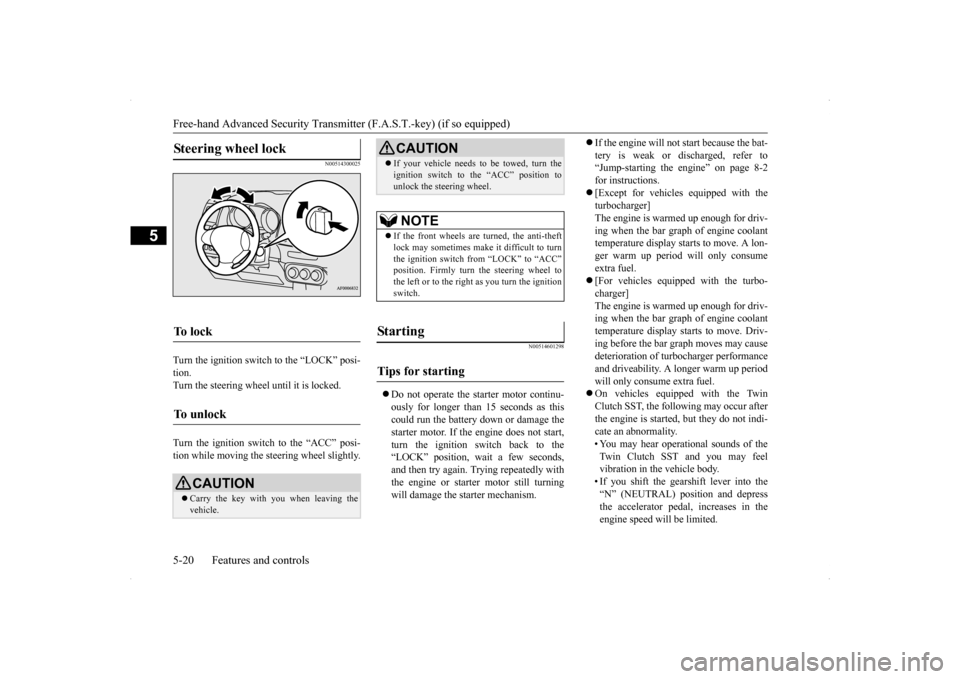
Free-hand Advanced Security Transmitter (F.A.S.T.-key) (if so equipped) 5-20 Features and controls
5
N00514300025
Turn the ignition switch to the “LOCK” posi- tion.Turn the steering wheel until it is locked. Turn the ignition switch to the “ACC” posi- tion while moving the steering wheel slightly.
N00514601298
Do not operate the starter motor continu- ously for longer than 15 seconds as thiscould run the battery down or damage the starter motor. If the engine does not start, turn the ignition switch back to the“LOCK” position, wait a few seconds, and then try again. Trying repeatedly with the engine or starter motor still turningwill damage the starter mechanism.
If the engine will not start because the bat- tery is weak or discharged, refer to “Jump-starting the engine” on page 8-2 for instructions. [Except for vehicles equipped with the turbocharger] The engine is warmed up enough for driv-ing when the bar graph of engine coolant temperature display starts to move. A lon- ger warm up period will only consumeextra fuel. [For vehicles equipped with the turbo- charger] The engine is warmed up enough for driv-ing when the bar graph of engine coolant temperature display starts to move. Driv- ing before the bar graph moves may causedeterioration of turbocharger performance and driveability. A longer warm up period will only consume extra fuel. On vehicles equipped with the Twin Clutch SST, the following may occur after the engine is started, but they do not indi-cate an abnormality. • You may hear operational sounds of the Twin Clutch SST and you may feelvibration in the vehicle body. • If you shift the gearshift lever into the “N” (NEUTRAL) position and depressthe accelerator pedal, increases in the engine speed will be limited.
Steering wheel lock
To l o c k
To u n l o c k
CAUTION Carry the key with you when leaving the vehicle.
If your vehicle needs to be towed, turn the ignition switch to the “ACC” position to unlock the steering wheel.NOTE
If the front wheels are turned, the anti-theft lock may sometimes make it difficult to turn the ignition switch from “LOCK” to “ACC”position. Firmly turn the steering wheel to the left or to the right as you turn the ignition switch.
St arting
Tips for starting
CAUTION
BK0200700US.bo
ok 20 ページ 2013年2月15日 金曜日 午後12時17分